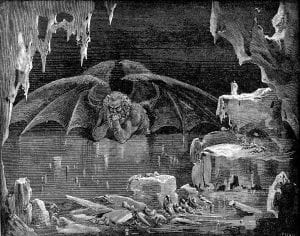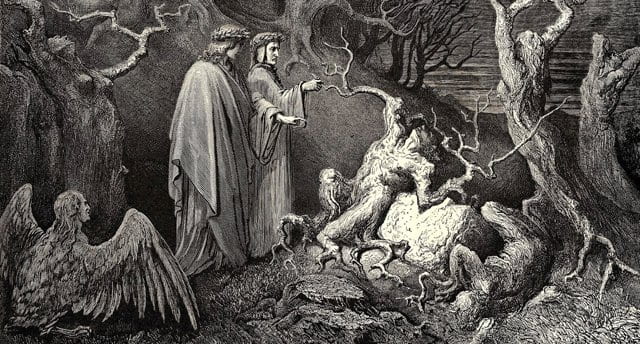The conception of hell as a frozen wasteland may seem surprising to people, as the general assumed temperature of hell is to be extremely hot. This basis is in fact proven in the Bible in several sections. In Revelations, hell is described as a “lake of fire.” There is also the geographical reasoning that states since Christianity originated from the Middle East and Africa, which are considered arid tropical climates, the idea that hell could be freezing cold, just like how their climate could ever be the same kind of cold, seems implausible. The New Testament also refers to hell as “Gehenna,” a term used by Bernard himself, which was historically a place outside of Jerusalem where waste was burned. In short, there is enough evidence to make the phrase “it’s hot as hell right now” make total and complete sense.

https://medium.com/@allthebigtrees/a-history-of-hell-gehenna-beyond-1f88863c7131
However, the fact that Bernard uses the term Gehenna to describe his vision of hell and yet still connotes it to being cold is interesting. How could this be possible? And the fact that the phrase “it’s cold as hell” exists and is used colloquially adds nuance to this idea. Syntactically and semantically, the phrase makes sense: it is an extreme feeling of one of the two ends of the temperature spectrum. However, cold and hell are two words that are oxymorons and are unable to work together in a sentence and yet, they do. Furthermore, there are many more interpretations of hell (or at least the further down in hell you go) the colder it gets. So, with all of these conditions, why do authors go against popular belief and create a cold hell? And why has a conception of a hot hell been more readily accepted than a cold one?
In class, we talked about how in Bernard of Cluny’s poem in three parts he describes hell as being cold:
“Hereafter shall their laughter be changed to weeping, and in the fires and pangs of death they yet die not. The torments of the wicked are as many and great as their sins, but of the many two are the worst, cold and fire” (89).
“Smoke rising from the fires burns one, fierce cold another. There is solid proof that the torture of cold and fire awaits the wicked when they die and begin to atone for their deeds” (90).
Although surprising, this isn’t the first nor the earliest depiction of hell as cold. In fact, we can go back and chronologically go through major works that have introduced visions of hell that are hot as well as cold. The first major work that does so–to my understanding–is the St. Paul’s Apocalypse, created in the fourth century. The text really develops on the St. Peter’s Apocalypse and is seemingly moralistic. One of the new features added is that one of the punishments is living in a realm of ice and snow.
“Again I saw men and women there with their hands and feet cut off. They were naked in a place of ice and snow and worms devoured them. When I saw this I wept and asked, ‘Who are these, Lord?’ He said to me, ‘These are the one who injured the fatherless and the widows and the poor and did not trust in the Lord. Therefore they pay their due penalty without ceasing'” (40).

https://upload.wikimedia.org/wikipedia/commons/thumb/b/bb/The_Conversion_of_Saint_Paul-Caravaggio_%28c._1600-1%29.jpg/1200px-The_Conversion_of_Saint_Paul-Caravaggio_%28c._1600-1%29.jpg
Even more interesting is that the people who deny the Resurrection, their eternal punishment is unceasing winter and cold:
“I saw there men and women who were gnashing their teeth in the cold. And I asked and said, ‘Lord, who are these in this place?’ He said to me, ‘These are the ones who say that Christ did not rise again from the dead, and that our flesh does not rise again.’ I inquired and said, ‘Lord, is there no fire or heat in this place?’ And he said to me, ‘In this place there is nothing but cold or snow.’ Again he said to me, ‘Even if the sun rose upon them, they would not be warmed because of the extreme cold in this place and the snow’” (43).
Continuing on, in the Old Testament Narratives (OTN), the creation of a cold hell was also described. However, what is even more interesting is that, unlike St. Paul’s Apocalypse, where new punishments were made to judge the sinners, God purposefully made hell hot and cold for the purpose of making his banished angels and Lucifer/Satan especially always endure a hard affliction:
“[God] formed a home in banishment for that traitor as a reward for his work, the howls of hell, hard tortures. Our Lord commanded the guardian of spirits to endure that torture chamber of exiles, deep, deprived of joy, when he knew it was ready, bound in unending night, filled with torment, pervaded with fire and intense cold, fumes and red flame” (5).
“There each and every enemy [the traitorous angels led by Lucifer] has an eternally kindled flame in an evening boundlessly long; then in the dawn the east wind comes, a frost tormentingly cold. Fire or cold, they must always have some hard affliction.” (25).
The ideas present in both St. Paul’s Apocalypse and OTN are quite vague and don’t give much explanation or room for interpretation about the temperature of their hells, which is interesting as they are the most biblical and canonical-adjacent texts I am talking about. It is when we reach more literary and creative interpretations that speculation about the meanings of these temperatures make sense.
The most famous depictions of cold hell come not from Biblical manuscripts or translations, but instead from literary interpretations and understandings of evil and heaven and hell: Milton’s Paradise Lost and Dante’s Inferno.

https://minervawisdomcom.files.wordpress.com/2019/01/paradise-lost.jpg
Milton’s dichotomy of warmth and cold expresses a dualism that contrasts God from Satan; this argument can also be applied to Milton’s use of light and dark, which represent similar if not exactly the same analyses. Milton’s use of warmth is reserved only for reference to earth and God’s natural prowess. Warmth applies to nature in Eden. The stars “forment and warm, Temper or nourish” (IV, 668). The sun’s rays “warm/Earth’s inmost womb” (V, 301-2). More importantly, the antonym of warmth “cold” and its synonyms, Milton only uses in relation to descriptions of Satan and his influence in Hell and on the real world. Thus, Milton is creating this idea that warmth, which is usually applied to hell and Satan, is instead good and representative of God while the cold is destructive and evil–this idea is not extremely far-fetched if you consider the seasons and its impact on the land: warmth brings blooms and birth while the cold brings barrenness and death.
Apparently unknown on earth until then, coldness enters with Satan. His arrival, like a vulture from the desolation of a “snowy ridge” (III, 432), portends Death’s future preying upon the world. Interestingly, before Satan actually descends upon earth he encounters Uriel, the first of the heavenly angels associated with Eden, and Satan’s ‘natural’ antithesis. Traditionally Uriel’s home is heaven’s Southern as opposed to Satan’s Northern region. After Satan leaves Uriel, however, he approaches Paradise from “the Mount that lies from Eden North” (IV, 569), and appears on the rim of Paradise like a sailor “beyond the Cape of Hope” where “off at Sea North-East winds blow.
In Dante, Satan is found in the innermost circle frozen in ice. Satan is portrayed as a giant demon, frozen mid-breast in ice at the center of Hell. Satan has three faces and a pair of bat-like wings affixed under each chin. As Satan beats his wings, he creates a cold wind that continues to freeze the ice surrounding him and the other sinners in the Ninth Circle. The winds he creates are felt throughout the other circles of Hell. In his three mouths, he chews on Judas Iscariot, Marcus Junius Brutus and Gaius Cassius Longinus. As punishment, God banished Satan out of Heaven to an eternity in Hell as the ultimate sinner.

https://upload.wikimedia.org/wikipedia/commons/a/ad/DVinfernoLuciferKingOfHell_m.jpg
It is in the fourth ring of the ninth circle, where the worst sinners, the betrayers to their benefactors, are punished. Here, these condemned souls, frozen into the ice, are completely unable to move or speak and are contorted into all sorts of fantastical shapes as a part of their punishment. Dante examines the sinners who are “covered wholly [by ice], / showing like straw in glass – some lying prone, / and some erect, some with the head towards us, / the others with the bottoms of the feet; another like a bow bent feet to face” (Canto 34, 231-2) This circle of Hell is a complete separation from any life and, for Dante, the deepest isolation is to suffer separation from the source of all light and life and warmth. If we want to relate this back to Milton, the 9th circle is the farthest one can be from Heaven, and thus, Satan and the three sinners in his mouth are the farthest from God’s healing warmth and thus will suffer in self-imposed cold.
All of this answers my first question: why did writers choose to describe hell as cold? However, this really doesn’t explain why a hot hell is the more popular interpretation. My thought process is that there is this idea of warmth present in God’s Heaven, seen in Milton. Perhaps, since hell is a twisted and wicked place for the wicked, this idea of warmth also gets corrupted, turning from a pleasant temperature to an overbearing and burning sensation. Like I said, conjecture and this post is already too long so I won’t get into it too much, but I wonder if you agree or disagree with this idea–or any of the ideas I presented here!
Bibliography
Henry Preble and Samuel Macauley Jackson. “Document. The Scorn of the World: A Poem in Three Books.” The American Journal of Theology 10, no. 1 (1906): 72–101. http://www.jstor.org/stable/3153862.
“St. Paul’s Apocalypse,” in Visions of Heaven and Hell Before Dante, ed. Eileen Gardiner (New York, New York: Italica Press, 1989), 13-46.
“The John Milton Reading Room.” Dartmouth.edu, Dartmouth College, 1997-2021. https://milton.host.dartmouth.edu/reading_room/contents/text.shtml.
https://wyomingcatholic.edu/wp-content/uploads/dante-01-inferno.pdf


